Erosion and urban waste at the Cape of Rodon: Solutions for the salvation of the Skanderbeg Castle
The Cape of Rodon and the Skanderbeg Castle are two great tourist potentials that are suffering from environmental problems related to erosion and urban waste. Amfora media through “Solutions Journalism” has identified concrete actions for these two natural and cultural monuments, aiming at their conservation.
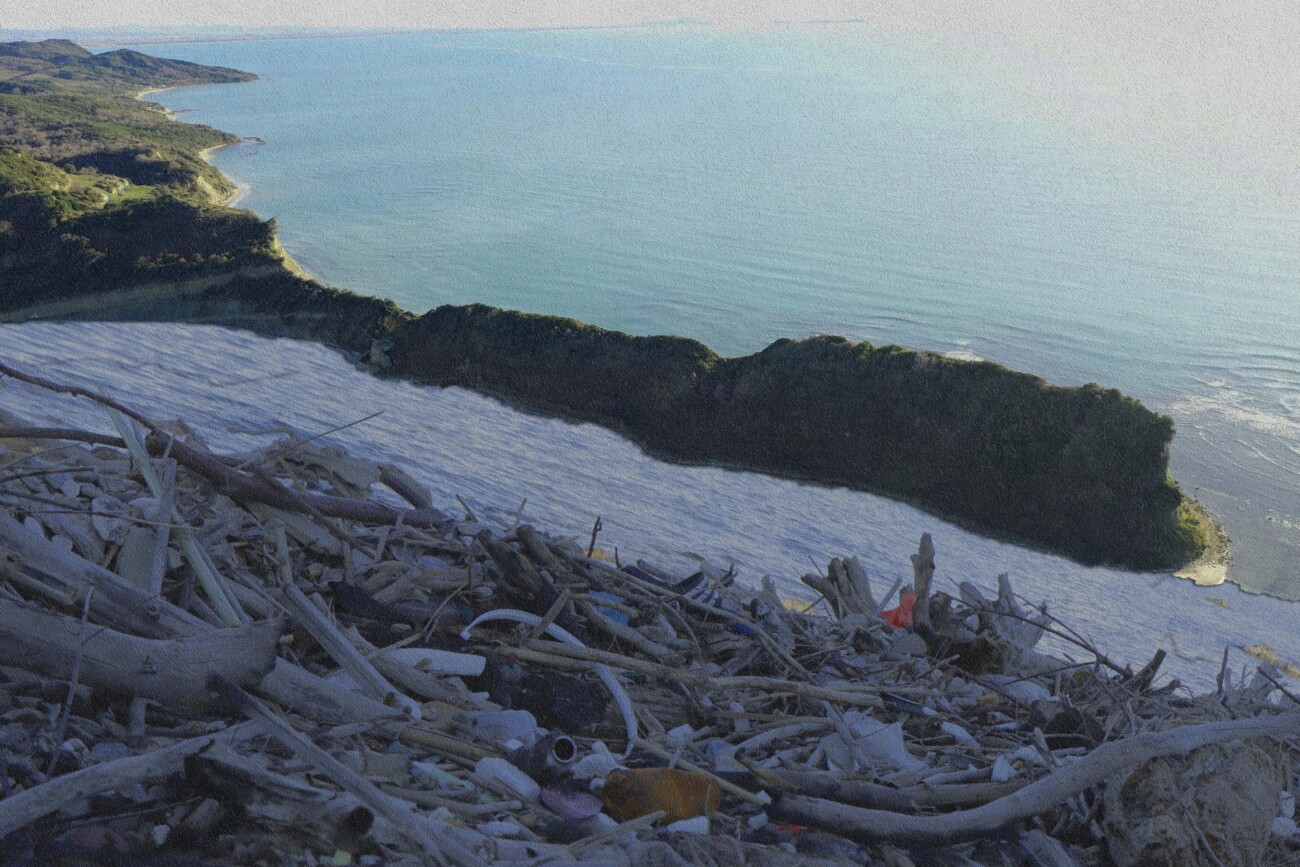
Illustrative graphic from Amfora Media
The Cape of Rodon is a bay that enters within the Adriatic Sea. Traces of habitation in the area date back to the 5thcentury B.C. and it is believed that in ancient times, this was a holy area dedicated to Redon, the Ilirian God of waters, sea, and earthquakes.
Today, there are cultural monuments of the first category, such as the “Skanderbeg Castle” and the Shën Ndout Church (St. Anthony Church). Their existence are threatened in the last few decades due to erosion, climate change, and urban waste.
Amfora Media and the “EDEN” Center, which is of environmental character, have carried out an on-sight investigation to determine the current situation and the possible solutions which would improve the environmental situation at the Cape of Rodon.
- Planting vegetation and incorporation of sediments to address erosion
The Cape of Rodon, and in particular the Skanderbeg Castle found at its furthest edge, are facing coastal and soil erosion for several decades. Bio-engineering solutions are recommended to improve the situation caused by erosion.
“The mitigation of sea waves through incorporating sediments near the shore, which would mitigate the wave blows on the sandy steep slopes,” identified as the first solution the environment expert Ermelinda Mahmutaj.
“Hence, such a measure would impact the stabilization of the slopes. The sediments near the shore allow the beach to regenerate itself, especially after a sea storm,” she added.
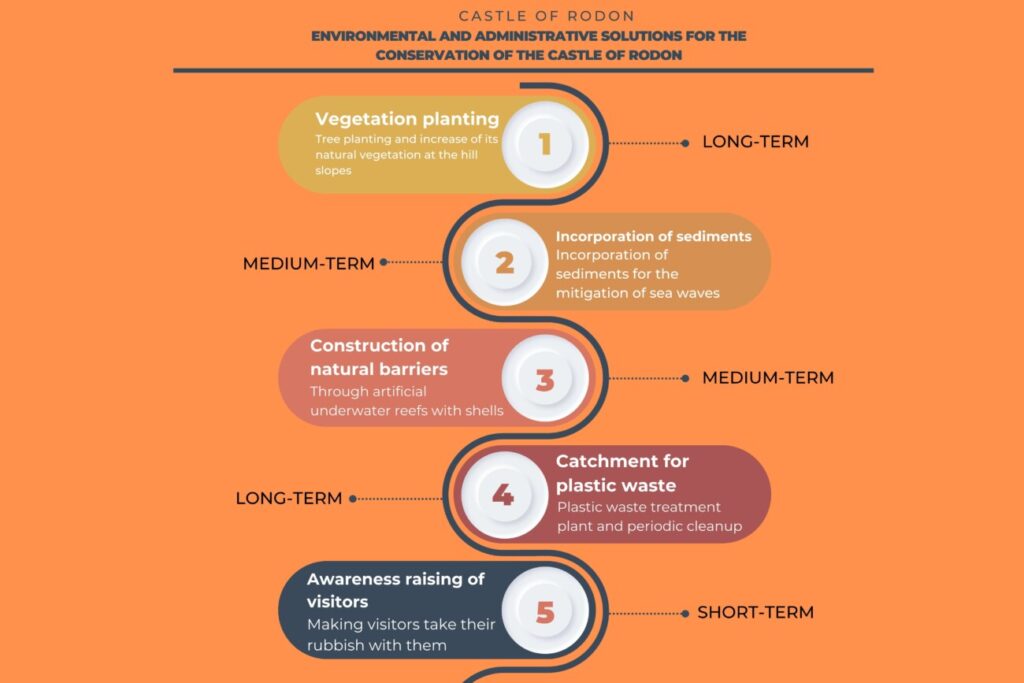
The fortification built by Skanderbeg has now become isolated from visitors. The pedestrian trail has been damaged less than a year ago and the only way to approach the castle now is through the sea.
By listing the engineering actions which should be considered as interventions to address the present situation, the second solution recommended is tree planting and increase of vegetation on the naked slopes of the hills, through clearly defined and localized campaigns at the steep areas where vegetation has been either uprooted or burnt.
“There should be an intensification of monitoring and denouncements for those who break the law in general, and those who destroy the vegetation coverage at the Cape of Rodon in particular,” suggested Ermelinda Mahmutaj.
Underwater archeologist Adrian Anastai has been carrying out continuous campaigns for marine and land terrain recognition since 2003. He explains that there is not much early information on the landscape of the area, however, the medieval historical sources provide an approximate idea.
“The cape has been very rich in timber, from this viewpoint, it has been protected from erosion. This phenomenon has not been obvious, meaning it has not been as aggressive as it is today,” Anastasi stated.
“As a result of the seawater erosion, parts of the walls have sunk under the Adriatic Sea waters,” it is said in the records of this cultural monument.
Coastal erosion, soil erosion, landslides of the hills, and sea level rise are forecasted to ruin within the next few decades the fortification erected by Skanderbeg in two future scenarios.
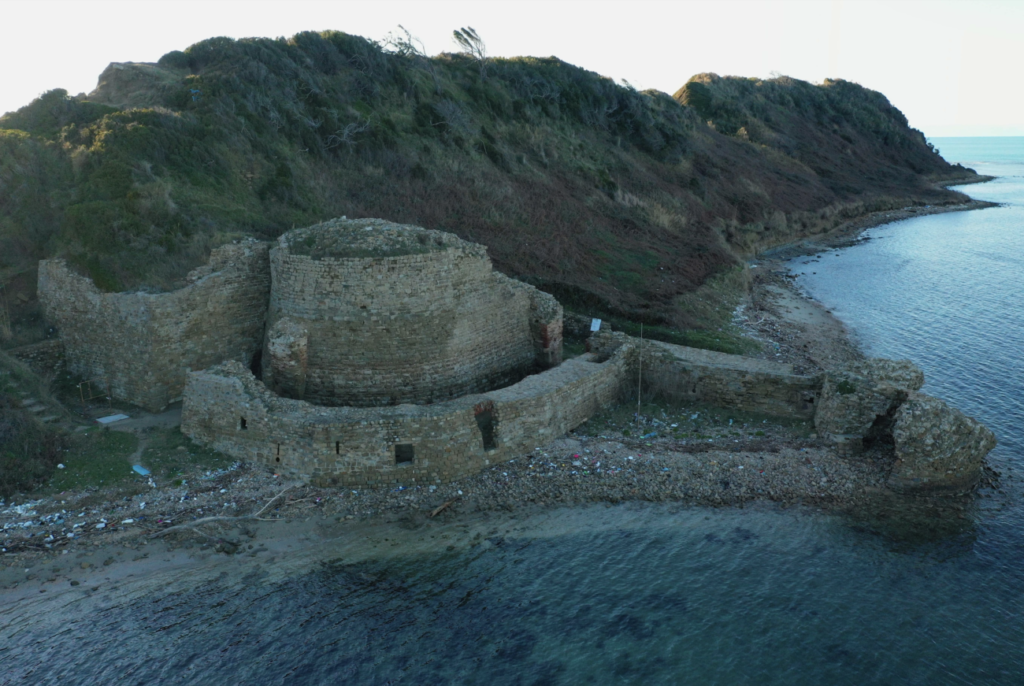
“This would bring the isolation of the castle and the worst-case scenario is its separation as an ‘island’ in the middle of the water, which would make it even more vulnerable to the different climate change effects. The castle would sink and ‘crumble’ in the water, drastically changing its surrounding landscape,” explained Mahmutaj.
The residents of the Shetaj village see the castle and the church as a symbol of the Ishëm area, while for the young people of this area, it is an opportunity to build their future through tourism.
Orgito Reka receives every visitor which goes to the Cape of Rodon. He politely raises and lowers the entrance barrier at the road which takes you to the peninsula, the territory which is administered by the Catholic Church through a private business.
“My peers, locals, and restaurants have similar jobs. This is how they work too,” the youngster said for Amfora Media.
“People are coming here even during the winter. There are visitors every day of the year, however, there are more tourists on Saturdays and Sundays. A couple of foreigners with a caravan arrived today,” Reka said.
“Everybody asks about the castle when they come and go. Some ask me why I didn’t tell them that there is no road taking them to the castle because they wanted to see it,” the 18-year-old boy added laughing and raising his shoulders as to remove blame because he was exhausted and forgot to remind the visitors of this important detail.
Not far from the fortification, there is the medieval “Chruch of Shën Ndout”, a cult monument that is protected even today, while historical sources show that the area once upon a time had several churches, monasteries, and assemblies.
“I came from Korça because I have heard many things about this holy church, hence I decided to visit it and pray for goodness,” said a man who was visiting this castle together with his family.
- The construction of natural barriers against the climate change
The Cape of Rodon enjoys the “Natural Monument” conservation status, due to its special natural, cultural, historic, and archeological characteristics and peculiarities.
A model which can be applied to reduce erosion has been implemented in New York in the United States of America and Oosterschelde in the Netherlands. It is related to the construction of artificial underwater walls/reefs with shells, which manage to mitigate waves and protect from erosion.
“Over time, these reefs can grow through the blocking of sediments and in this way, they can compensate for the sea level rise,” suggested as a second solution Mahmutaj.
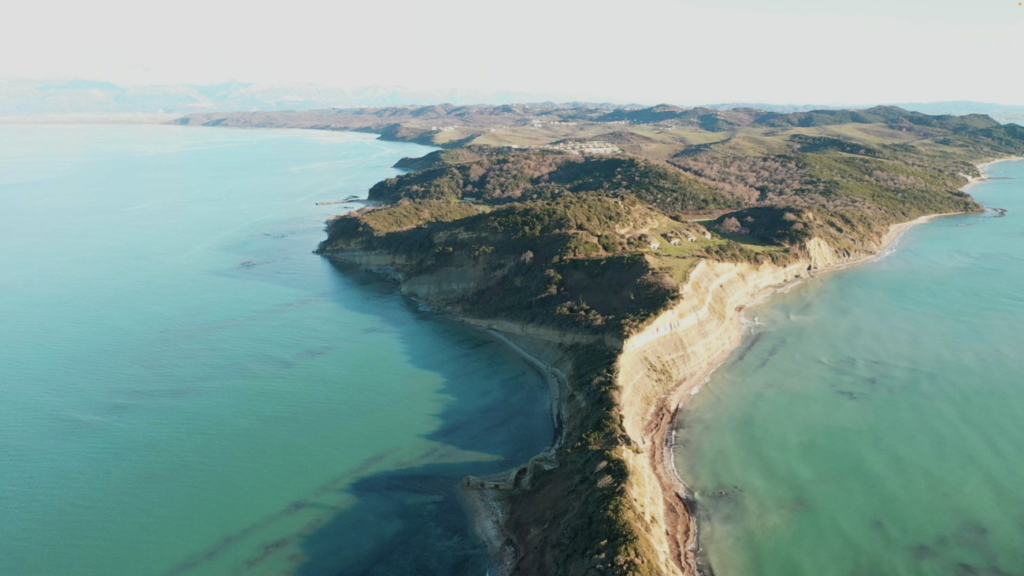
For the fortification, known as Castle of Currila (Kalaja e Currilave, në Muzhlin e Skënderbeut), a project for conservative interventions was approved on December 21st, 2020, according to decision no. 508, of the National Council on Tangible Cultural Heritage.
According to the Ministry of Culture, the earthquake of November 2019 caused damage to the castle. This institution admitted that in the last 5 years, there have been no conservation works on this cultural monument while the conservation project remains on paper for two years.
Among the solutions suggested, there is the creation of a protective barrier that would prevent/slow soil erosion caused by the advancement of seawater which will be done with three lines of concrete gabions (metallic cages filled with rocks).
According to the environment expert, Nature-Based Solutions (NBS) and Ecosystem-based Adaptation (EbA) are the most suitable solutions, as officially defined in the Convention on Biological Diversity (CBD) of 2009. They are part of the global strategy to aid people to adapt to the negative effects of climate change.
“We need to highlight that in the cases where the accumulation of natural barriers is slowlier than the sea level rise, in general, ecosystem-based adaptation is easier to be modified than engineering solutions of concrete structures for the coastal protection,” suggested Ermelinda Mahmutaj.
To read the full “Environmental overview” prepared by the EDEN Center for Amfora Media, read it below:
The fortification of Skanderbeg Castle has rectangular planimetry, equipped with four protection pillars and a turret. Even today, the main pillar which is 10 meters high, and several protection walls with 3.5 meters of thickness are preserved. It was built in 1451 together with a scaffold that would ensure the connection with the sea. Later on, the fortification was used by the Venetians.
- Investment at the catchments for plastic wastes and periodic cleanup
The Ishëm River is formed by the unification of the Tirana River with Tërkuza and Zeza streams. It drains at the Adriatic Sea tons of plastic wastes gathered throughout its flow which crosses Tirana, Vora, Kamza, Fushë-Kruja, and other areas of Kurbin, ending at the tight coast of the Cape of Rodon.
“The Municipalities along the Ishëm River should seriously invest for the waste collection and the small catchments to prevent waste from being discharged at the river, especially in the rural areas where the waste management service is not always present,” listed as a first solution for the urban wastes, environment expert Ermelinda Mahmutaj.
Several institutions need to coordinate their work to resolve the waste management issue at the Cape of Rodon, as well as its maintenance, administration, and functioning as a natural monument and a monument of cultural heritage.
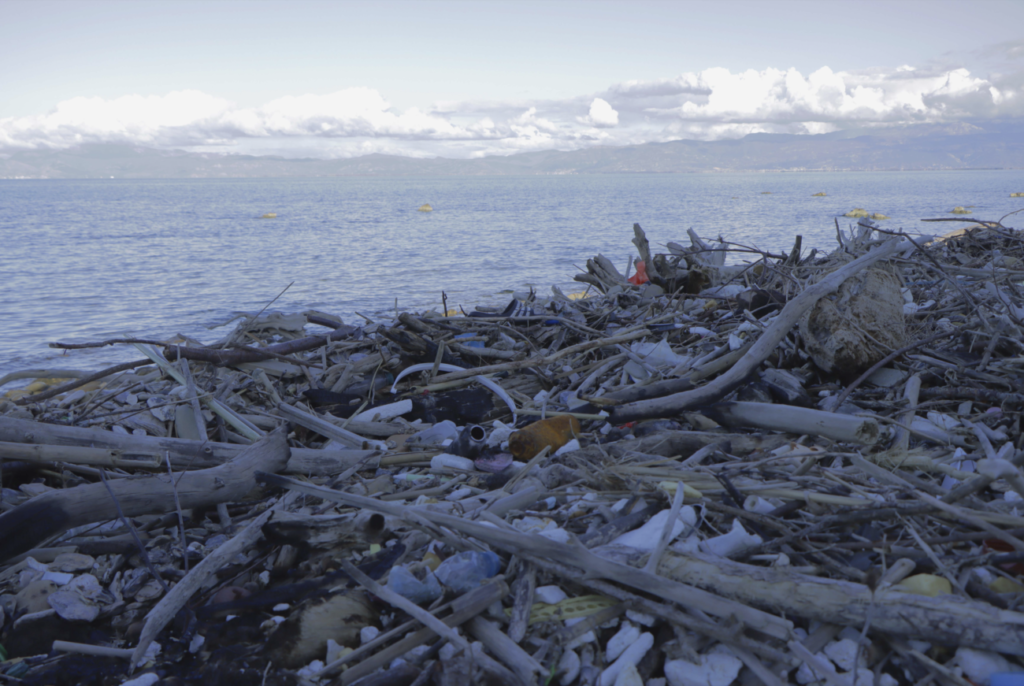
“For the sustainable and effective resolution of the issue of the waste discharge at the Rodon from the Ishëm River, an interinstitutional group needs to be established to capitalize on the division of duties and responsibilities for the resolution of the problem,” suggested as part of the solution the environment expert.
“Durrës Municipality occasionally cleans up the estuaries of the Ishëm and Erzen Rivers, organizing actions as a municipality, but such a thing does not take place every day,” officially responded the Durrës Municipality.
As a solution specifically addressing plastic waste it has been suggested that the waste treatment and catchment plant at the Gotulla Reserve is put to work, as well as the resolution of the administrative procedure issue.
“The Ministry of Tourism and Environment should cooperate with the ‘The Ocean Cleanup’ initiative for the restoration and improvement of infrastructure of the Gotulla plant. Representatives of this initiative have expressed interest to invest and monitor this plant in Albania,” listed as part of the practical intervention Ermelinda Mahmutaj.
The Ministry of Tourism and Environment officially responded to Amfora Media that the construction of this plant cost ALL 202.603.181 (around EUR 1.7 million) while construction works ended in December 2017.
It was built by the “Integrated Technology Services” company, which later was placed under preventive seizure following an order of the Special Court against Corruption and Organized Crime, for its involvement as a subcontracting company in concessionary projects for the construction of incinerators.
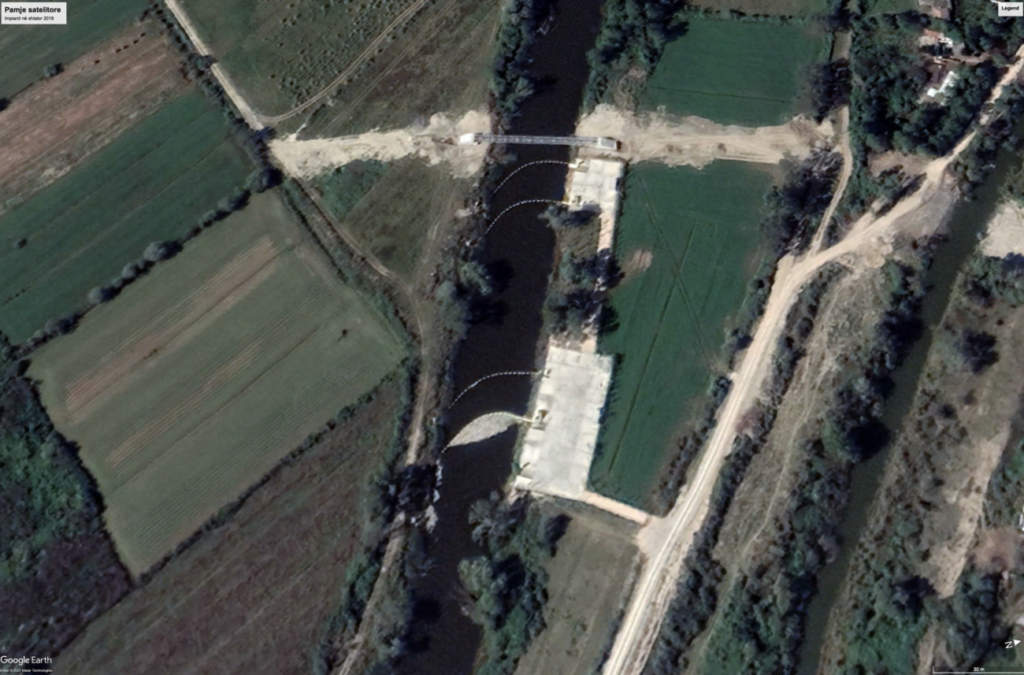
The Ministry of Tourism informed that the act-calibration procedure of works has been carried out, without clarifying the current situation of the investment and whether it is still functional. Furthermore, the “Integrated Technology Services” company did not respond to our request for comments.
“Today this plant is out of function due to the lack of maintenance and disagreement between the local governments of the areas crossed by the Ishëm River regarding its administration,” stated expert Mahmutaj.
Archeologist Adrian Anastasi explained that for several years through the cooperation of the Ministry of Culture and the institutions which fall under its dependence, archeological expeditions have taken place, however, work has not been easy considering the piles of plastic waste over and under the water.
According to him, if erosion is present for decades or centuries, plastic is a phenomenon of the last 30 years, which cannot be resolved with cleanup actions.
“We have been there before. We have visited the area for our goals, to see the marine navigation-related phenomena,” said Anastasi speaking of the coast of the Cape of Rodon and the estuary of the Ishëm River.
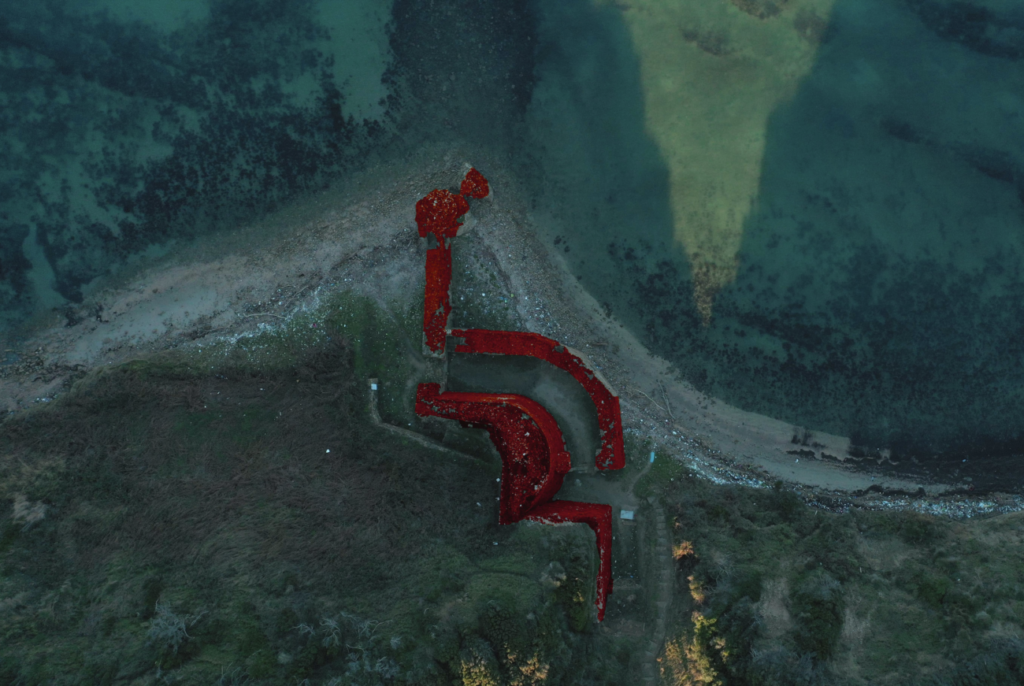
- Awareness-raising of the visitors
Laura Gjyli, has organized cleanup actions in Albania, in particular at the Ishëm River estuary, for many years now in the framework of the “River Cleanup” world movement which aims to remove rubbish from water. She stated that according to the “The Ocean Cleanup”, this river drains to the Adriatic Sea some 730.000 kg of solid wastes, mostly plastic.
“There have been 20 schools and the Aleksandër Moisiu University of Durrës involved in our activities. The main focus of our work has been recycling and environmental education,” Gjyli said to Amfora Media.
She explained that the strategy has been focused on the cleanup of Ishëm River through the engagement of communication and education in schools and the university as well as the involvement of private companies and institutions.
Furthermore, for the environment expert, Ermelinda Mahmutaj, part of the solution is the creation of an awareness-raising campaign for the visitors who litter at the archeological and natural sites.
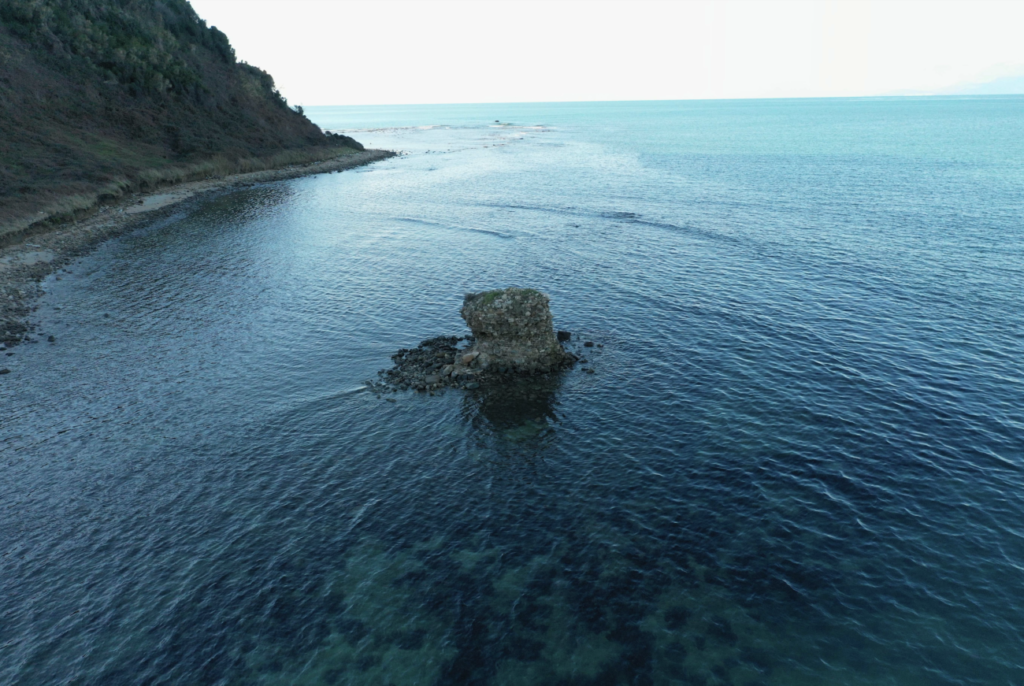
In their official response, Durrës Municipality stated that urban waste collection at the Castle of Rodon, which is a cultural monument, is done by the institutions which have cultural monuments under their dependence.
“… because the company which collects the wastes cannot approach the area which is around 20km away from the last village, which is Shetaj (the AFA Group company operates up to the Shetaj village),” responded the Durrës Municipality.
In the meantime, the Ministry of Culture explained that the Institute of the Cultural Inheritance Monuments does not administer information nor does it manage infrastructure for the collection of urban wastes. According to the environment expert, Ermelinda Mahmutaj, this concept should not exist anymore because the collection of wastes from natural and archeological sites should not be the institutions’ duty.
“Institutions of culture and environment which work in the monuments of the cape do not have the administrative mandate of collecting wastes. In the meantime, the Durrës Municipality cannot send its waste collection vehicles due to the rough terrain,” noted the environment expert.
“Hence the entire situation remains in the hands of the engaged citizen. The focus of the campaign should be awareness raising and informing the citizens who throw their rubbish on the road and nature. The collection of such trash does not fall under the competence of any institution, however, it is regulated by the Criminal Code, as ‘Environment Crime’ and is punished through fines,” concluded Mahmutaj.


